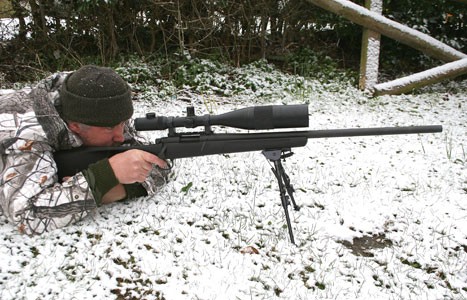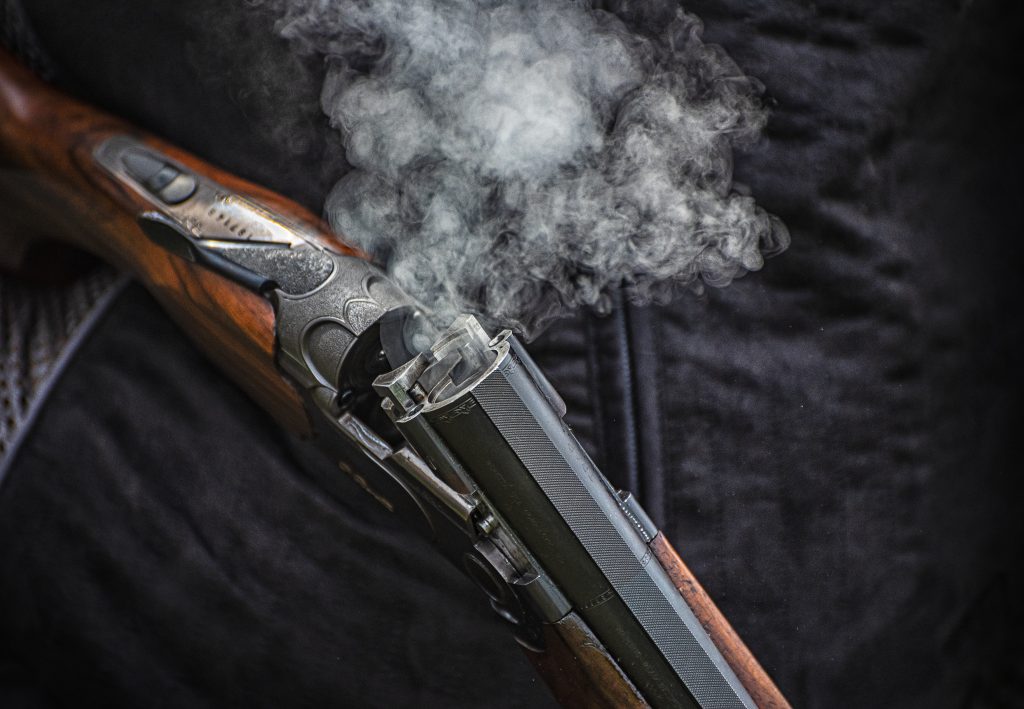Win CENS ProFlex DX5 earplugs worth £1,149 – enter here
Testing the .17 calibre Fireball round
Testing the .17 calibre Fireball round: Certain smaller calibre rounds have their roots in the swinging Sixties, but, says Bruce Potts, it took many decades and Remington’s blessing for them to join the Establishment.

Testing the .17 calibre Fireball round.
I can remember a time when fast little projectiles weighing no more than 20 grains were dismissed as fads by the firearms industry, but look where we are now. The new .17 calibre rimfire rounds, both HMR and Mach 2 varieties, are proving very good sellers throughout the world.
The rise of the new 20 calibres such as the .204 Ruger and the extremely efficient 20 Tactical have proved that there can still be new developments in ballistics despite the wealth of cartridges already in existence. The new sub-calibre is designed to be quieter, with lighter recoil and flat-shooting vermin potential in a small, cost-effective case. As well as its own .17 round based on a .223 case, Remington now offers a .17 Fireball based on a .221 Fireball case.
Are they really new?
Ideally designed for vermin use, the parent .221 Fireball case has an overall length of 1.4in and capacity of a little more than 23 grains. Sales have been inconsistent as shooters have sometimes gone for faster and larger cartridges thinking they would be better. In some cases a .223 is far better, but if you shoot foxes or vermin at normal ranges ? that is, at less than 250 yards ? the smaller Fireball case is really all you need.
This was understood long before Remington firearms introduced its .17 calibre. A firm from Las Vegas called the O?Brien Rifle Company introduced a necked-down version of the .221 Fireball case called the .17 Mach IV in the mid-1960s. It has taken Remington more than 40 years to realise its true potential and as with so many other wildcat calibres this recognition has legitimised it. There are some very minor differences to the neck and shoulder of the case but for all intents and purposes the old and new cartridges are the same.
The .17 Fireball can muster the magical 4,000fps velocity from a 24in test barrel with a 20-grain V-Max bullet. Its nearest competitor is the Remington in the .17 Remington case, which propels the same bullet at 4,200fps. At these speeds the extra velocity is academic and with the Fireball there will be less barrel fouling, barrel and throat erosion, noise recoil and powder consumption.
One factory load
As with all small-calibre rifles it is advisable to keep an eye on any fouling in the bore as pressures can rise very swiftly, which can ruin a rifle and cause injury by splitting the barrel. There is only one factory load, which has a 20-grain Accutip-V bullet. Remington claims this will give a velocity of 4,000fps and 710ft/lb of energy. The bullets, whose ballistic coefficient is low at only 0.185, have a flat trajectory, which means that as long as your rifle is accurate you can aim dead-on up to 200 yards with a 150-yard zero.
The Remington SPS I had on test was a Varmint model with a 26in barrel. Starting with a one-shot-and-clean regime to settle in the barrel, the factory loads were producing 4,060fps velocity and 732ft/lb energy. Only one factory load means you are a bit limited but on the other hand if you do not reload ammunition then the choice is made and by learning the characteristics of the load you can become more efficient.
Rating the reloads
Reloading is where you can really push the Fireball, running a variety of special bullets through the rifle to determine optimum performance and accuracy. The bullets ranged from 15 grains to 30 grains with both hollowpoint and polymer tips. It is a small case with a small powder capacity of only 18 to 19 grains. It is therefore a highly efficient case to launch a 20-grain bullet at more than 4,000fps. In this instance, faster burning powders are best and I chose IMR 4198, RL 7, RL 10X and Vit N130, though H4227 and Vit N133 would also suffice.
Particular attention must be given to accurate powder weighing as stated before.
A special .17 calibre powder funnel helps guide the powder smoothly into the case and I used a precision Harrell powder dispenser, which delivers precisely the correct powder throws time and again. However, you may want to weigh each individual charge. I mostly used Federal Match small primers, though CCI were also very consistent. No attention to the case is needed before reloading other than the usual deburring of the neck and the cleaning of the primer pocket and the inside of the neck area. Deburring the internal flash hole, however, does improve the odds of consistent ignition and it is also worth squaring the primer pocket.
Bullet choice
The 20-grain V-Max bullet is perfectly matched to this calibre and remains probably the best .17 bullet design to date. As it is flat-based, seat the bullet carefully into the tiny neck of the case to avoid ripples. The point where the rifling starts in the chamber should dictate the best seating depth. With this bullet, 16.0 grains dead of IMR 4198 gave 3,891fps and 673ft/lb energy from the 26in barrel. The same weight of Vit N133 produced 3,801fps and 642ft/lb. Accuracy with both hovered at the 0.85 mark for three shots at 100 yards, which is fine. A consistent load was achieved with 16.0 grains of RL 7 powder, which gave 0.65in groups at 100 yards. Though the velocity was down to 3,674fps, it was a good load.
When you up the ante to 25 grains with either a V-Max or Berger bullet, the velocity falls quickly given the bullet is only five grains heavier. With this bullet a load of 15.5 grains IMR 4198 produces 3,711fps and 765ft/lb. This is very respectable and has the added advantage of a higher ballistic coefficient of 0.230 making it more wind slippery. The 30-grain Berger bullets are really too large in this case size. Velocities of 3,576fps were achieved with a load of 15 grains of Vit N130. The Berger is a bit tougher than the V-Max so it penetrates better but it does not expand as violently.
At the other end of the scale. I tested some Berger 15- and 18-grain bullets with very open hollowpoint cavities called Maximum Expansion Factor (MEF). These make great vermin loads and with 16.5 grains of RL 10X produce 3,889fps and 504ft/lb energy. Accuracy was okay but even at these speeds they lose a lot of energy over a small distance. For the .17 Fireball the best choice has to be the 20- or 25-grain bullet weights. All these reloads are a little slow, I did increase the loads but started to see more pressure signs so I stopped. Every rifle is its own enigma and should be tested accordingly. The factory ammunition has the bullet seated deeply with a very tight crimp, which may explain the difference.
In the field
This is where all the hard work of tuning a rifle to find its preferred diet pays off. I loaded it with 40 rounds of 20-grain V-Max over 16 grains of IMR 4198. I worked out that, zeroed at 150 yards, I would be 0.1in high at 100 yards and only 1.1in low at 200 yards. This meant crows in the field needed minimal elevation adjustment and with a fox I needed to aim dead-on. The Remington SPS, though a long gun, even without a moderator fitted, harvested game cleanly. It was superb on foxes with lethal non-exiting shots. As long as wind-drift is taken into account, the super-efficient and flat-shooting .17 Fireball is a really useful calibre. I have a friend who also has an SPS rifle with an 18in barrel and his factory loads produce 3,732fps and 619ft/lb, which is all he wants as the addition of a PES muzzle moderator makes the combination a perfect fox ?Truck? gun.
Read more gun reviews!
Related Articles
Get the latest news delivered direct to your door
Subscribe to Shooting Times & Country
Discover the ultimate companion for field sports enthusiasts with Shooting Times & Country Magazine, the UK’s leading weekly publication that has been at the forefront of shooting culture since 1882. Subscribers gain access to expert tips, comprehensive gear reviews, seasonal advice and a vibrant community of like-minded shooters.
Save on shop price when you subscribe with weekly issues featuring in-depth articles on gundog training, exclusive member offers and access to the digital back issue library. A Shooting Times & Country subscription is more than a magazine, don’t just read about the countryside; immerse yourself in its most authoritative and engaging publication.







